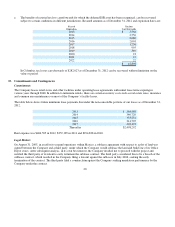Office Depot 2012 Annual Report Download - page 152
Download and view the complete annual report
Please find page 152 of the 2012 Office Depot annual report below. You can navigate through the pages in the report by either clicking on the pages listed below, or by using the keyword search tool below to find specific information within the annual report.
The Company amortizes the cost of its intangible assets with definite useful lives over such estimated useful lives. These
lives are reviewed at least annually to determine whether events and circumstances warrant a revision. Useful lives are as
follows:
10
g.
I
mpairment of long-lived assets in use
—
The Company reviews the carrying amounts of long-lived asset in use, other than
goodwill and intangible assets with indefinite useful lives, when an impairment indicator suggests that such amounts might
not be recoverable, considering the greater of the present value of future net cash flows or the net sales price upon disposal.
Impairment is recorded when the carrying amounts exceed the greater of the aforementioned amounts. Impairment
indicators considered for these purposes are, among others, operating losses or negative cash flows in the period if they are
combined with a history or projection of losses, depreciation and amortization charged to results, which in percentage
terms in relation to revenues are substantially higher than that of previous years, obsolescence, competition and other legal
and economic factors.
h. Goodwill and intangible assets
—
Goodwill represents the excess of consideration paid over the fair value of the net assets
acquired in subsidiary shares, as of the date of acquisition. Through December 31, 2007, goodwill was restated for the
effects of inflation using the NCPI. Intangible assets with indefinite useful lives are carried at cost. Goodwill and intangible
assets with indefinite useful lives are not amortized and are subject to impairment tests at least once a year, regardless of
the existence of im
p
airment indicators.
Years
Customer list
5
Non-com
p
ete a
g
reement
10
i.
P
rovisions
—
Provisions are recognized for current obligations that arise from a past event, that are probable to result in the
use of economic resources, and that can be reasonabl
y
estimated.
j
.
D
irect employee benefits
—
Direct employee benefits are calculated based on the services rendered by employees,
considering their most recent salaries. The liability is recognized as it accrues. These benefits include mainly statutory
em
p
lo
y
ee
p
rofit sharin
g
(“PTU”)
p
a
y
able, com
p
ensated absences, such as vacation and vacation
p
remiums, and incentives.
k.
E
mployee benefits for termination, retirement and other
—
Liabilities related to seniority premiums and, severance
payments are recognized as they accrue and are calculated by independent actuaries based on the projected unit credit
method usin
g
nominal interest rates.
l. Statutory employee profit sharing (PTU)
—
PTU is recorded in the results of the year in which it is incurred and presented
under selling, administrative and general expenses in the accompanying consolidated statements of income. Deferred PTU
is derived from temporary differences that result from comparing the accounting and PTU bases of assets and liabilities
and is recognized only when it can be reasonably assumed that such difference will generate a liability or benefit, and there
is no indication that circumstances will change in such a way that the liabilities will not be paid or benefits will not be
realized.
m.
I
ncome taxes—Income tax (“ISR”) and the Business Flat Tax (“IETU”) are recorded in the results of the year they are
incurred. To recognize deferred income taxes, based on its financial projections, the Company determines whether it
expects to incur ISR or IETU and, accordingly, recognizes deferred taxes based on that expectation. Deferred taxes are
calculated by applying the corresponding tax rate to temporary differences resulting from comparing the accounting and
tax bases of assets and liabilities and including, if any, future benefits from tax loss carryforwards and certain tax credits.
Deferred tax assets are recorded onl
y
when there is a hi
g
h
p
robabilit
y
of recover
y
.
























